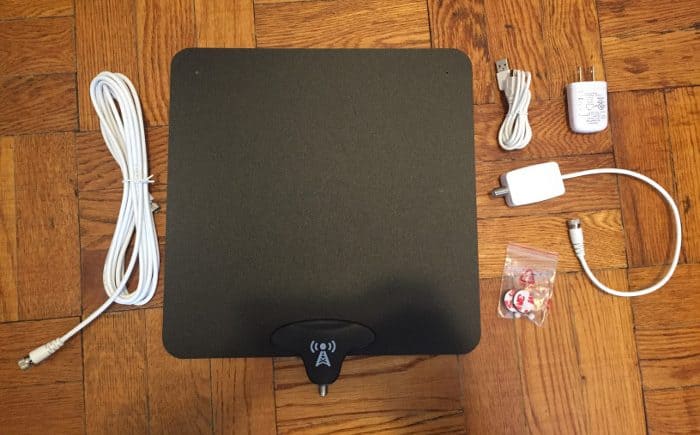
- HD TV antennas are a major modern upgrade from the rabbit ears of the past.
- Combining streaming services and a TV antenna is a great way to expand your channel listings, especially for local networks like ABC and CBS.
- Installing an antenna is simple and can be done in fewer than five steps.
- Ready to install your OTA antenna? Pick from our list of the best TV antennas to find one that’s right for you.
Cable TV has gotten progressively more expensive over the years. But those thinking about cutting the cord are still looking at a variety of costs, from having to pay for streaming content to shelling out monthly payments for a solid internet connection. So what is the solution for those who don’t want to pay for cable and internet, or who find themselves on a tight budget but still want to enjoy some of their favorite TV events? A digital antenna might be just the answer you’re looking for.
Yes, TV antennas are still a thing. In fact, they’re better than ever. Modern indoor antennas offer HD channels for free. If you’re interested in learning more about antennas and what channels you’ll be able to watch for free, we’ve got you covered.
Over-the-Air TV
Over-the-air (OTA) TV is a great way to catch your local channels without spending the big bucks for cable. OTA TV offers high-definition television broadcasts from your local television stations. All you need to start is a TV and a digital antenna. If you’re looking to get rid of cable and have no interest in paying for streaming services, OTA TV is the way to go. Which brings us to the question: What can you actually watch with just an antenna?
What Channels Can You Get With OTA TV?
Depending on your location and reception, you should be able to get some or all of the major networks (ABC, CBS, NBC, and FOX) as well as nationally televised sports and news. You can visit the Federal Communications Commission’s DTV Reception Map website to get exact details on the coverage in your area. There, you can type in your address and get a comprehensive list of all the channels in your area as well as their signal strength. If you live in an area with poor reception, you may not get any channels at all, in which case you can at least celebrate the fact that all you spent on this wonderful experience was a few bucks for the antenna (indoor TV antennas sell for as low as $10).

How to Install an Antenna
So you’ve decided to give OTA TV a try. But without access to technical support, how do you go about installing an indoor antenna? (There’s also the option of getting an outdoor antenna, typically installed on the roof of a house. If you opt for that, we strongly recommend getting the help of a professional. We have an entire page devoted to the types of TV antennas available, which you can look at for more detailed information.) Here are the general steps to install an antenna:
- Purchase an antenna. You can easily order one from Amazon or pick one up from an electronics store like Best Buy. We don’t recommend anything too fancy, as your location, not the model of your antenna, will determine which channels you’ll be able to pull in. If your location has poor reception, a more expensive antenna will not be able to remedy that. For additional help, you can check out our suggestions on how to choose a TV antenna.
- Mount the antenna to a wall or window, as high as possible. Play around with the placement to see what works best. (The antenna should be facing your local station broadcast towers, the locations of which you can find online.)
- Connect the antenna cable to your TV or DVR.
- Scan for channels.
- If you’re able to get a good-quality picture and channels, you can even purchase an antenna DVR and record content so that you’re able to watch whenever you want and skip through commercials.
What If My Antenna Isn’t Picking Up Any Channels?
If you’re having trouble pulling in channels, there are a few things to consider before giving up altogether.
- Have you placed your antenna in a bad spot? Anything from a tree to a tall building can block the signal from the broadcast tower to your antenna. Try moving the antenna to a different spot and see if there is any improvement.
- If you are using a splitter, you are running the risk of messing with your antenna’s reception. We recommend going without it or using an amplifier to boost the signal.
- How long is your coaxial cable? If it’s over 100 feet, that might be an issue. Once again, if you can’t move the antenna closer, try using a preamplifier.
For more information on getting a better antenna signal, take a look at our How to Get Clear TV Antenna Reception guide. If none of those fixes work, there’s a possibility that you live too far away from a broadcast tower, in which case your foray into the OTA universe probably has to come to an end.
Pros and Cons of OTA TV
If you’re still wondering whether to give OTA TV a chance, let’s run through the pros and cons.
Pros
- No monthly payments
- Simple equipment
- Major local news networks
- Easy install
Cons
- No technical support
- Small list of channels
- Service depends on location
- No choice in content
If you don’t watch a ton of TV and you’re mostly interested in local coverage and prime-time TV, then getting free TV with the help of an antenna might be a good first step on your cord-cutting journey.
Another Way to Watch TV Without Internet or Cable: Offline Viewing
If after reading all this you’re still not digging the idea of purchasing an antenna, another way for getting content without having cable or internet is offline viewing. Streaming services require an internet connection, but that doesn’t mean that they require you to have one all the time. Many services provide the option of downloading their content for offline viewing.
For example, you can sign up for Netflix and download TV shows and movies at a time when you have access to the internet — like during non-peak hours, when data might be cheaper, or when you’re at the coffee shop or library, where Wi-Fi is free. You can then watch your downloads later without an internet connection. The shows and movies available for offline viewing will have a download icon (usually an arrow).
Final Thoughts on OTA TV
For those who want to get local channels without paying for them, OTA TV is a great way to go. And with the sleek antenna designs, you’re not going to feel like you’re sitting in your grandparents’ house and watching grandpa fiddle with the rabbit ears to clear the static from the screen. You can even use an OTA DVR to record live TV if you so desire.
On the other hand, if you like having control over your content and access to multiple shows and a wide range of channels, an antenna is most likely not going to satisfy your needs. Take a look at our reviews for streaming services like Hulu + Live TV and Sling TV to decide if those might be better suited for you.
If you’re still flirting with the idea of cutting the cord but you’re afraid of missing out on news, sports, and prime-time TV, giving OTA TV a try won’t cost you anything beyond the price of an antenna. We also recommend checking out our guide to essential antenna tips for cord-cutters.


